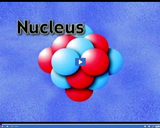
The nucleus is the dense core of an atom. It contains over 99 percent of the mass of an atom, but occupies a miniscule amount of the space.
- Subject:
- Science
- Provider:
- Utah Education Network
- Author:
- Visual Learning Company
- Date Added:
- 02/28/2010

The nucleus is the dense core of an atom. It contains over 99 percent of the mass of an atom, but occupies a miniscule amount of the space.
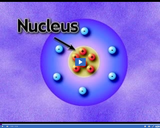
In Rutherford's model of an atom, positively charged particles are concentrated in a small, dense center of an atom called the nucleus. Negatively charged electrons are scattered around the nucleus.
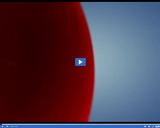
Electrons are precisely one two-thousandth of the mass of a proton or neutron.
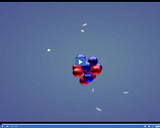
The nucleus of an atom contains positively charged protons and neutrally charged neutrons. Negatively charged electrons orbit the nucleus.

This video segment adapted from A Science Odyssey takes a look at the scale of the atom and the tremendous amount of space between the electrons and the nucleus. If all this empty space exists in matter, how can any substance be solid?

This interactive map allows students to see how the attack on Pearl Harbor occurred with pictures, oral testimony, and timeline of events.

In this episode of UEN's PDTV, preservice teachers Aniston and Mallory reflect on their first professional conference at the Utah Coalition for Educational Technology (UCET) annual event. They’ll share their top ten tips for conference preparation, and through their insights, you’ll learn how to maximize your next professional conference experience.

Many online sources are untrustworthy. The attention conservation poster reminds students to seek out credible online sources and not waste their time on untrustworthy ones. Note: A free educator account is required to access these materials.

Novel representations and diverse perspectives can reveal new insights into complex systems, and can support rich understandings of the world. In this activity, students will identify and analyze the choices artists and scientists make when creating representations of living or non-living natural objects. This process will help students recognize the potential and place for their own articulation of how the world works. After drawing from nature, students will reflect on the process of representing information, then compare their drawings with that of a 16th-century artist. Students will consider what is included and what is excluded, and hypothesize about larger contexts and systems.
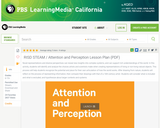
Novel representations and diverse perspectives can reveal new insights into complex systems, and can support rich understandings of the world. In this activity, students will identify and analyze the choices artists and scientists make when creating representations of living or non-living natural objects. This process will help students recognize the potential and place for their own articulation of how the world works. After drawing from nature, students will reflect on the process of representing information, then compare their drawings with that of a 16th-century artist. Students will consider what is included and what is excluded, and hypothesize about larger contexts and systems.

A Critical Introduction to U.S. Government and Politics
Word Count: 243127
(Note: This resource's metadata has been created automatically by reformatting and/or combining the information that the author initially provided as part of a bulk import process.)
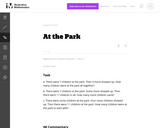
These 3 word problems require students to solve addition and subtraction problems.

Article looking at the choices Washington made during critical days of the Revolution. Could be used as a case study to look at washington's choices he made.

What drives changes to classic myths and fables? In this lesson students evaluate the changes Disney made to the myth of "Hercules" in order to achieve their audience and purpose.

Students explore using electronic messaging and Internet abbreviations for specific purposes and examine the importance of using a more formal style of writing based on their audience.

Page 10 of Playwriting with Young People by Julie Jensen read by Kallie Fillanda.

Page 11 of Playwriting with Young People by Julie Jensen read by Kallie Fillanda.

Pages 12-13 of Playwriting with Young People by Julie Jensen read by Kallie Fillanda.

Page 14 of Playwriting with Young People by Julie Jensen read by Kallie Fillanda.

Page 15 of Playwriting with Young People by Julie Jensen read by Kallie Fillanda.